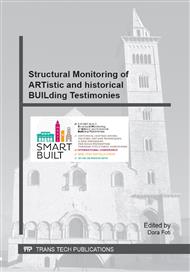[1]
Lang, K., Seismic vulnerability of existing buildings, Dissertation submitted to the Swiss Federal Institute of Technology (ÉPFZ), Zurich (2002).
Google Scholar
[2]
Calvi, G.M., Pinho, R., Magenes, G., Bommer, J.J., Restrepo Vélez, L.F., Crowley, H., The development of seismic vulnerability assessment methodologies over the past 30 years, ISET Journal of Earthquake Technology, Paper No. 472, 43(3) (2006).
Google Scholar
[3]
Giovinazzi S., Lagomarsino S., Damage Assessment of current buildings at territorial scale: Model calibrated on a macroseismic vulnerability model, Interdisciplinary Workshop on management of Earthquake Risks, ETH, Zurich, Switzerland, August 28-29 (2006).
DOI: 10.1007/s10518-006-9024-z
Google Scholar
[4]
Restrepo Vélez, L.F., MAGENES G., Simplified Procedure for the Seismic Risk Assessment of Unreinforced Masonry Buildings", 13th World Conference on Earthquake Engineering Vancouver, B.C., Canada, 2561 (2004).
Google Scholar
[5]
Foerster E., Krien Y., Dandoulaki M., Priest S., Tapsell S., Delmonaco G., Margottini C., Bonadonna C., Methodologies to assess vulnerability of structural systems, ENSURE PROJECT, WP1: State-of-the-art on vulnerability types, 3 (2009).
Google Scholar
[6]
Dumova-Jovanoska, E., Fragility Curves for RC Structures in Skopje Region, Proceedings of the 13th World Conf. on Earthq. Eng., Vancouver, Canada, 3 (2004).
Google Scholar
[7]
Cardinali, M., Reichenbach, P., Guzzetti, F., Ardizzone, F., Antonini, G., Galli, M., Cacciano, M., Castellani, M., and Salvati, P.: A geomorphological approach to estimate landslide hazard and risk in urban and rural areas in Umbria, central Italy, Natural Hazards and Earth System Sciences, 2: 1–2 (2002).
DOI: 10.5194/nhess-2-57-2002
Google Scholar
[8]
Reichenbach S, Dieppe PA Williams S, Gregg P, et al,. Assessing bone loss on radiographs of the knee in osteoarthritis: A cross-sectional study. Arthritis and Rheumatism 52(11) (2005) 3536-3541.
DOI: 10.1002/art.21418
Google Scholar
[9]
T. Chanpheng, H. Yamada, H. Katsuchi, E. Sasaki, Nonlinear features for damage detection on large civil structures due to earthquakes, (2012).
DOI: 10.1177/1475921712437182
Google Scholar
[10]
K. D'Souza, B. I Epureanu, Damage detection in nonlinear systems using system augmentation and generalized minimum rank perturbation theory, (2005).
DOI: 10.1088/0964-1726/14/5/037
Google Scholar
[11]
Charles R. Farrar et al., Nonlinear System Identification for Damage Detection, (2007).
Google Scholar


